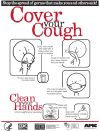Chapter 9. Educational process. Recommendations and standard operating procedures for intensive care unit and hospital preparations for an influenza epidemic or mass disaster
- PMID: 20213424
- PMCID: PMC7080136
- DOI: 10.1007/s00134-010-1768-x
Chapter 9. Educational process. Recommendations and standard operating procedures for intensive care unit and hospital preparations for an influenza epidemic or mass disaster
Abstract
Purpose: To provide recommendations and standard operating procedures (SOPs) for intensive care unit (ICU) and hospital preparations for an influenza pandemic or mass disaster with focus on education of all stakeholders, specifically the emergency executive control groups, ICU staff and staff co-opted to assist with patient management.
Methods: Based on a literature review and expert opinion, a Delphi process was used to define the essential topics, including staff education.
Results: Key recommendations include: (1) define functional roles and responsibilities of the internal personnel and interface agencies or sectors; (2) determine logistic support and requirements necessary for the effective implementation of the SOPs; (3) determine what is required to maintain the SOPs; (4) recommended training and activities include: (a) personal protection techniques; (b) environmental contamination; (c) medical management; (d) laboratory specimens; (e) alert lists; (f) training of recruited staff; (g) ethical issues; (h) psychosocial issues; (i) dealing with the deceased; (j) policies for restricting visitors; (k) mechanisms for enforcing policies; (5) Training should begin as soon as possible with daily demonstrations followed by supervised practice; (6) identify the staff to participate in training programs, verify that they have participated and evaluate their knowledge subsequently.
Conclusions: Judicious planning and adoption of protocols for staff education are necessary to optimize outcomes during a pandemic.
Figures
References
-
- Devereaux AV, Dichter JR, Christian MD, et al. Definitive care for the critically ill during a disaster: a framework for allocation of scarce resources in mass critical care: from a Task Force for Mass Critical Care summit meeting, January 26–27, 2007, Chicago, IL. Task Force for Mass Critical Care. Chest. 2008;133(5 Suppl):51S–66S. - PubMed
-
- London DH (2007). Pandemic flu: a national framework for responding to an influenza pandemic. http://www.dh.gov.uk/en/Publicationsandstatistics/Publications/PublicationsPoli.... Accessed 25 Oct 2009
MeSH terms
LinkOut - more resources
Full Text Sources
Medical


